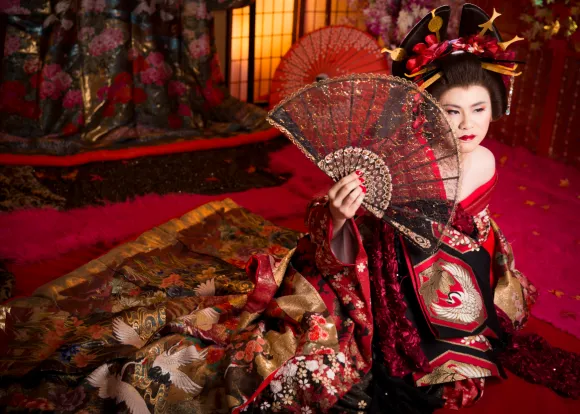What Does Crossdressing Mean?

Crossdressing, simply put, means to dress up as the opposite gender. This is based on society’s binary view of gender, which equates to specific roles, and specific clothing. If clothing is not so specific for women anymore (they can and do wear pants), there is still a strong stigma around men wearing skirts or dresses.
Crossdressing also happens in the context of traditional performing arts, historically and until today. Some troupes are male-only or female-only, which leads to men taking on the roles of female characters and vice-versa.
What is “Crossdressing” in Japanese?
There are several words that mean “crossdressing” in Japanese. Josou (女装) is the most commonly used one, and refers to men wearing women’s clothing, but also a general term for crossdressing (as, we have established, it is most often men who crossdress). On the opposite, there is dansou (男装), for women who crossdress into men. There is one non-gendered option, but it is way less commonly used: iseisou (異性装) meaning “opposite-gender clothes”.
In theater, we find onnagata (女形 or 女方) or oyama (女形), who are men playing women’s role in a traditional theater form called kabuki. The equivalent also exist for women, as otokoyaku (男役) are women who play men’s roles, specifically in Takarazuka Revue. In this troupe, there are also musumeyaku (娘役), who are women who played overexaggerated female role to counterpart the otokoyaku. So, there is such a thing as women crossdressing into women!
Finally, in modern culture, there is otokonoko (男の娘), which has the opposite meaning of its usual pronunciation meaning “boy”: the last kanji is switched from the “ko” of “child” to that of “daughter”, and refers to a younger man wearing women’s clothing or having a feminine appearance in general. This is a term mainly used in manga, anime, and internet culture.
Japanese Crossdressing History
Japanese people haven’t always been so uptight about gender roles as they may be today. This phenomenon is largely due to the Westernization of Japan. People used to be comfortable being naked in gender-free public baths!
If kabuki was created in the early Edo period and Takarazuka Review in 1913, crossdressing has existed for longer than that. In history, literature, and ukiyo-e (traditional woodblock printings), crossdressing has been part of traditional culture for a long time.
Example include:
Yamato Takeru
Yamato Takeru was a warrior who dressed up as a woman to beat the enemy. On the other hand, there was Ushiwakamaru, who dressed up as a man to fight Benkei.
Benten
Benten the thief dressed up as a woman to accomplish a heist, and is now a common character in kabuki.
Okuni
Before women were forbidden to play kabuki in 1629, women would crossdress as men for performances as well as Onnagata, and were called Okuni.
Ukiyo-e

In ukiyo-e, it was common to switch the gender of the main historical character in order to make them stand out for “parody pictures”.
Geishas

During the Edo period, geishas would dress up in men’s garb for certain festivals and perform skits called Sukeroku.
Japanese Crossdressing in Modern Culture
In modern culture, crossdressing still remains as part of traditional theater. Beyond this, the differences between crossdressing, drag, and even transgender identities tend to blur. With that being said, there still remain some pure hardened crossdressers, such as Matsuko Deluxe or Hideaki Kobayashi.
Check out our list of popular Japanese crossdressers!
There is also something to be said about the trending art of cosplay. In cosplay, which is the act of costuming as a (usually) fictional character, the gender of the person cosplaying doesn’t really matter. Indeed, it is common to see women cosplaying as male characters and, albeit less commonly so, men cosplaying as female characters. This is the true evolution of crossdressing into modern culture, alongside drag.
Do Japanese Schools Allow Crossdressing?
As of just a few years ago, some schools have allowed students to wear whatever gendered uniform they desire. A 2021 study by Kankō Gakuseifuku, a school uniform maker, found that 60% of Tokyo universities allow LGBTQ+ students to wear whatever they want. However, in practice, only 3% of schools allow male students to wear skirts. Meanwhile, a high percentage of girls wear pants in order to fight the low temperatures in winter. In conclusion, girls tend to wear pants for comfort, while assigned male students tend to wear skirts for gender expression.
Crossdressing: Meaning for LGBTQ+ People?
The approach to LGBTQ+ identities and crossdressing tends to be inverted between the West and Japan. In Japan, some people may start by crossdressing and afterward realize that they are gay or transgender. In the West, the realization of one’s identity tends to come first.
If from an outsider’s eye it tends to mix everything up, it still remains a great option for closeted or even just straight, cisgender people to express themselves, which does not commonly exist in other countries.
Read about what it’s like to live as a transgender person in Japan!
Conclusion
There is a rich and long history of crossdressing in Japan. Starting from legends and theater, it evolved into a somewhat common practice in the modern world. Some people may choose to crossdress in order to feel comfortable, to shock, or to convey certain values. This history should not be ignored and should be celebrated as it is due.





